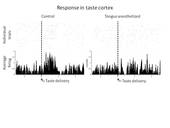Highlight
Electrophysiological proof that food preferences are learned via olfactory cues alone.
Achievement/Results
One of the challenges of neuroscience is to understand how the brain processes sensory information so that the animal can decide what actions to take. Of great importance is understanding how animals use taste and smell to decide which substances to eat, and which are potentially dangerous. At Brandeis University, NSF-funded IGERT trainee Caitlin Piette is working on a project to understand the relationships between taste and smell. To this end, the investigators implant many electrodes in the rat’s brain, and then make recordings from the brain as the animal is behaving naturally.
The lab recently published a paper (Fortis-Santiago, Rodwin, Neseliler, Piette, and Katz, Nat Neurosci 2010) that shows that the part of rat cortex devoted to taste is actually involved in the olfactory perception of food. To prove this conclusively, it first was necessary to show that the rats were actually engaged in an olfactory perception task, and not a taste task. IGERT trainee Caitlin Piette showed that this was in fact the case. She topically anesthetized rats’ tongues, and showed that they still learned to prefer foods with a particular odor (top panel, center set of bars). Then she implanted electrodes into taste cortex, recorded single-neuron activity before, during, and after anesthetizing the tongue, and analyzed the electrophysiological data using techniques learned in computational classes taken as part of her IGERT training. These data demonstrated conclusively that no TASTE information reaches the brain while the rats were involved in this olfactory task.
Address Goals
Understanding exactly how taste and smell signals are processed in the brain is crucial for understanding how animals of all species make decisions about which substances are palatable. Moreover, understanding how learning in the taste system occurs will be very important for understanding what signals drive animals and humans to overeat when food is freely available. This work requires a cadre of investigators who can make very difficult recordings from the brain of behaving animals, and who are skilled in developing quantitative methods for analyzing complex data.






